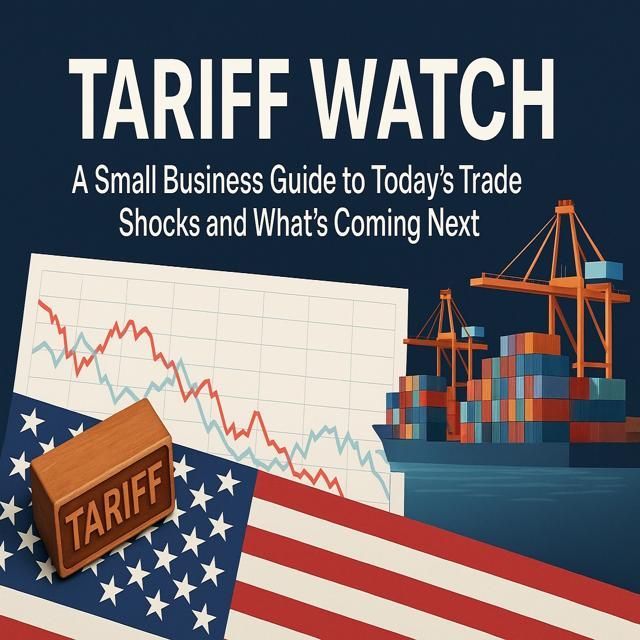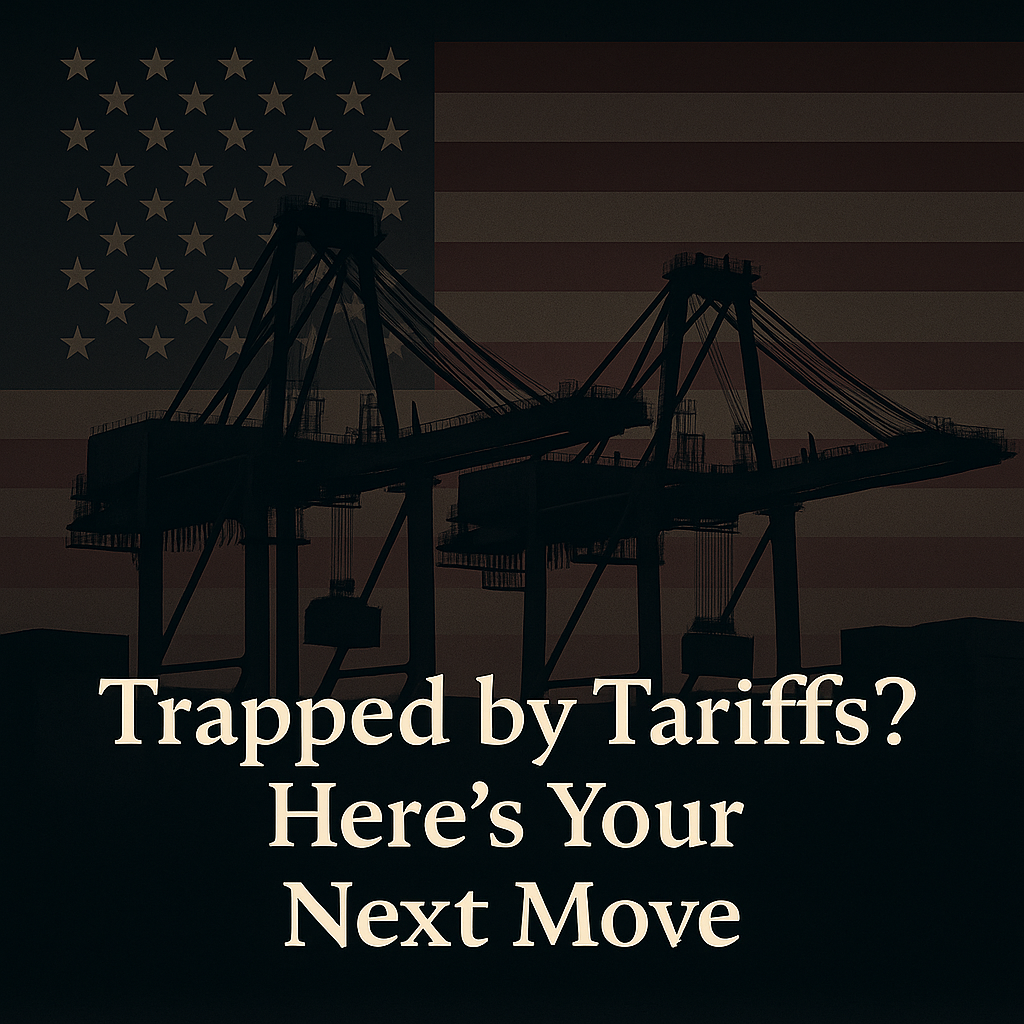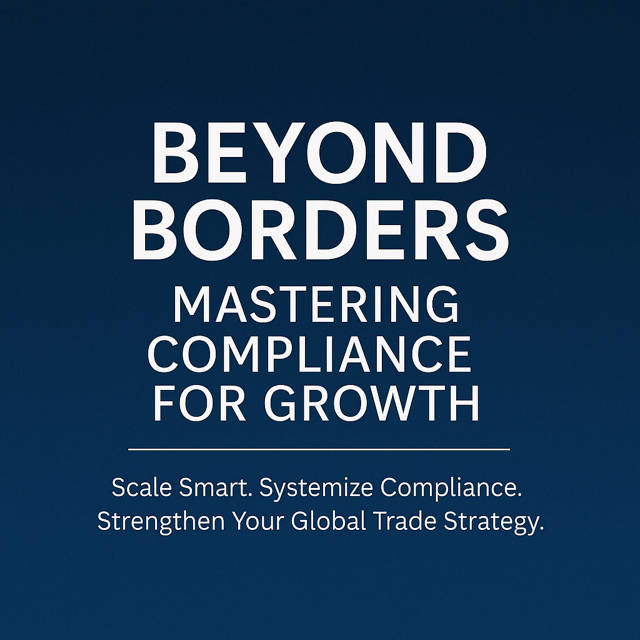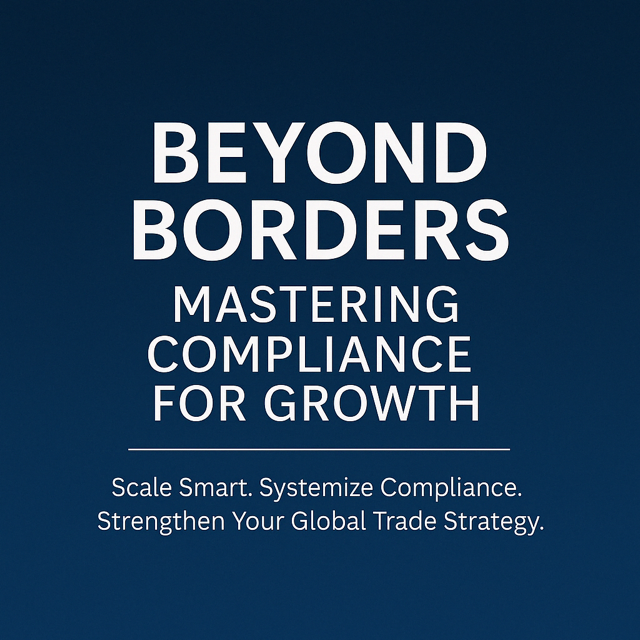
Audio Conversation:
Full Blog Article:
The trade climate of 2025 has become more unpredictable than ever, with sweeping U.S. tariffs and reciprocal actions by key trading partners reshaping global supply chains. For small and midsize businesses (SMBs), these changes have triggered higher costs, compliance headaches, and the need for rapid strategy shifts.
From the end of the de minimis exemption to 25% tariffs on automobiles and parts; 2025 has brought a fundamental reset in global trade priorities under President Donald Trump’s administration.
This article, the first in our five-part series,
“Tariff Watch: A Small Business Guide to Today’s Trade Shocks and What’s Coming Next,” dives into what’s changed, what’s on the horizon, and how your business can prepare.
What’s Changed in 2025 Tariff Policy
China: Expanded Section 301 Tariffs, Reciprocal Tariffs, and New Targeted Measures
China remains a primary focus of U.S. trade enforcement in 2025. The Biden administration previously expanded Section 301 tariffs to cover additional key industries, including electric vehicles (EVs), semiconductors, solar components, critical minerals, and certain medical devices, to reduce U.S. dependency on Chinese supply chains.
Under President Trump, these measures have not only remained in place but have been intensified. In 2025, the administration:
- Imposed a 20% tariff on opioids and related precursor chemicals, targeting both finished pharmaceutical products and raw ingredients linked to the U.S. Opioid crisis.
- Imposed a U.S. Reciprocal tariff rate of 10%, applying broadly across all Chinese imports in addition to the existing Section 301 measures.
Current Tariff Rates on Chinese Goods:
- Electric Vehicles (EVs): 100%
- Semiconductors: 50%
- Solar panels and components: 50%
- Battery components & critical minerals: 25–50%
- Medical devices and supplies: 25%
- Opioids and related precursor chemicals: 20%
- Reciprocal tariff rate increase: 10%
Impact on U.S. SMBs:
For Small and midsize businesses, these combined actions mean dramatically higher landed costs, strict compliance requirements, and a higher risk of enforcement actions for transshipment or misclassification. SMBs relying on Chinese goods should evaluate alternative sourcing markets such as Vietnam, Thailand, or India, explore tariff engineering strategies, and prepare for potential further escalation in trade tensions.
De Minimis Rule Eliminated (Section 321)
The de minimis exemption, which allowed goods under $800 to enter duty-free, has been eliminated.
- May 5, 2025: China was excluded from de minimis eligibility.
- August 29, 2025: De minimis will be eliminated for all countries.
Impact on U.S. SMBs:
For SMBs, this change means that all shipments, regardless of value or country of origin, must now go through formal customs entry procedures. This shift will significantly increase both the cost and administrative burden of e-commerce and small-package imports, as duties will apply across the board. To manage compliance efficiently and avoid delays, many businesses will now find that working with a customs broker or implementing an automated entry system is essential, even for low-value orders.
Copper Tariffs: All Countries
Effective August 1, 2025, a 50% tariff was imposed on all copper and copper derivative imports under Section 232. This tariff impacts:
- Copper wiring, tubing, and fittings
- HVAC and electrical components
- Automotive and construction materials
Autos and Auto Parts: All Countries
Automobiles and auto parts now face tariffs that apply to all countries.
- Automobiles: As of April 3, 2025, a 25% tariff applies to imported cars and light trucks from most countries.
- Auto Parts: Effective May 3, 2025, a 25% tariff was implemented on certain imported parts, including engines and engine parts, transmissions and powertrain components, and electrical systems.
While these measures apply broadly to global suppliers, there are exceptions for qualifying goods under the U.S. - Mexico- Canada Agreement (USMCA) that meet strict rules-of-origin requirements.
The UK Exception: Under the newly negotiated U.S.-UK trade agreement, certain British automobiles and auto parts benefit from reduced tariff rates, making the UK a potentially strategic sourcing alternative for U.S. importers seeking to offset higher costs from other markets.
For most small and midsize businesses, however, these Section 232 Tariffs mean higher landed costs, potential supply chain realignment, and the need to reassess sourcing strategies to remain competitive.
India: Reciprocal Tariffs Increased
Effective August 1, 2005, the U.S. raised its reciprocal tariffs on imports from India from 10% to 25%. Tensions have escalated further following Washington's warning that additional tariff measures could be imposed if India does not reduce its purchases of Russian oil. A stance rooted in both geopolitical strategy and national security concerns.
Impact on U.S. SMBs:
Higher costs for importing Indian goods, including pharmaceuticals, textiles, and raw materials. Increased uncertainty for supply chains reliant on Indian suppliers, particularly for active pharmaceutical ingredients (APIs). Greater need to evaluate alternative sourcing options or renegotiate supplier contracts to manage rising costs and potential future tariffs.
For many small businesses, this is a reminder that trade policy with India is being shaped not only by economics but also by foreign policy, making proactive risk assessments more critical than ever.
Mexico: Tariff Measures Linked to Southern Border Security and Reciprocal Duties - Trade Talks Extended
While auto parts and produce imports from Mexico remain under scrutiny, the U.S. and Mexico have agreed to extend trade talks by 90 days. This temporary extension means no new tariffs have been implemented yet, but:
- Transshipment of Chinese goods via Mexican ports is being closely monitored
- Agricultural subsidies remain a flashpoint for future tariffs.
Impact on U.S. SMBs:
For small and midsize businesses, heightened scrutiny on imports from Mexico, particularly auto parts, agricultural goods (including avocados, berries, and peppers), and products suspected of being transshipped from China, means higher compliance costs, potential shipment delays, and more stringent documentation requirements to prove USMCA eligibility. Businesses failing to meet rules-of-origin thresholds risk unexpected duties, while those in targeted sectors could face sudden tariff hikes if the current 90-day trade talks collapse.
SMBs should tighten supplier oversight, conduct regular sourcing audits, and develop contingency plans for alternative suppliers.
Canada: Tariffs on Strategic Goods, Illicit Drug Concerns, and Reciprocal Actions - Ongoing Trade Friction
Canada has faced multiple tariff measures in 2025, which will affect key sectors of its exports to the U.S. The 50% global copper tariff applies to Canadian copper and copper derivative products, impacting industries from construction to automotive manufacturing. In addition, the U.S. has reinstated a 17.9% tariff on softwood lumber and is enforcing stricter USMCA rules of origin for auto parts.
A notable development is the introduction of new U.S. tariffs aimed at disrupting the flow of illicit drugs and precursor chemicals entering through Canadian supply chains. These measures are part of a broader cross-border security initiative to address the opioid crisis and synthetic drug trafficking.
Canada has responded with its reciprocal tariff increase, raising duties on select U.S. exports. While the list of targeted goods varies, this escalation adds cost pressure for SMBs engaged in two-way trade with Canada.
Impact to SMBs:
SMBs importing from Canada now face higher costs not only from the copper and lumber tariffs but also from increased enforcement measures tied to illicit drug prevention. Stricter USMCA origin verification means importers of auto parts and manufactured goods must maintain precise documentation to avoid unexpected duties. Businesses exporting to Canada also need to account for the reciprocal tariffs that may increase costs for U.S.-made goods. For SMBs operating on both sides of the border, this environment demands tighter compliance controls, regular supplier audits, and contingency plans for sourcing alternatives.
New U.S.-UK Trade Deal
In a rare positive development, the U.S. and the UK finalized a new bilateral trade agreement in July 2025. This deal:
- Reduces tariffs on British steel and automotive goods entering the U.S
- Enhances mutual recognition of standards for pharmaceuticals and medical devices
- Opens new market access for U.S. agricultural exports to the UK
Impact on U.S. SMBs:
The newly signed U.S.-UK trade agreement offers SMBs a rare opportunity to reduce costs on certain imports, including automotive products, steel, and pharmaceuticals, through lower tariff rates compared to the global basis. however, these benefits are contingent on meeting the agreement's rules of origin and certification requirements. SMBs importing from the UK should act quickly to identify eligible products, adjust sourcing strategies to take advantage of reduced rates, and ensure proper documentation to claim preferential treatment.
What’s Still on the Table: Future Tariff Threats
European Union(EU): Climate and Digital Services Disputes
The EU’s Carbon Border Adjustment Mechanism (CBAM) continues to impact U.S. exporters of carbon-intensive goods. The U.S. is evaluating reciprocal tariffs on:
- European pharmaceuticals and chemicals
- Luxury goods such as wines and high-end fashion
- Additional green-tech components
Impact on U.S. SMBs:
Tensions with the EU over climate policy and digital services taxes may soon result in retaliatory tariffs on pharmaceuticals, chemicals, and luxury goods. For SMBs importing from EU member states, this means monitoring potential rate hikes and assessing cost exposure now, rather than waiting for official announcements. Businesses should evaluate sourcing diversification, explore FTZ or bonded warehouse options for delaying duties, and ensure their products are classified correctly to avoid being caught by sector-specific tariff lists.
Brazil: Agricultural and Commodity Tariffs
Ongoing WTO disputes with Brazil over sugar, ethanol, and grain exports could result in:
- U.S. tariffs on Brazilian beef, soy products, and orange juice.
- Brazilian retaliation on U.S. machinery and fertilizers.
Pharmaceuticals: Tariffs Under Review
For the first time, pharmaceuticals and APIs (active pharmaceutical ingredients) are being considered for tariffs, particularly those sourced from China and India. A proposal is under review to impose 15–25% duties on critical medical imports to encourage U.S. production.
How a Customs and Freight Broker Helps SMBs
In a year where tariffs are both complex and fast-changing, SMBs can’t afford to go it alone. A customs and freight broker can help you:
- Identify tariff exposure and plan for upcoming rate hikes.
- Navigate post-de minimis compliance, ensuring all shipments meet U.S. entry requirements.
- Leverage trade agreements, including the new U.S.-UK deal, to reduce costs.
- Implement FTZ and bonded warehousing strategies to delay or reduce duties.
- Stay informed on reciprocal tariffs and sourcing risks with proactive consulting.
At Magnetic Precision, we specialize in helping SMBs build resilient import/export strategies that anticipate trade shocks.
Summary: Key Takeaways
- De minimis is eliminated for all countries as of August 29, 2025, requiring formal customs entry and duty payment on every import, regardless of value. China lost eligibility earlier on May 5, 2025.
- China remains a primary target under expanded Biden-era Section 301 tariffs on key industries and additional Trump-era measures, including a 20% tariff on opioids and precursor chemicals and a reciprocal tariff of 10% on all general goods.
- India is now subject to a 25% reciprocal tariff (up from 10% as of August 1, 2025), with the U.S. warning of further action if India does not reduce Russian oil imports.
- The U.S. has imposed a 50% global tariff on copper and copper derivatives, impacting imports from all countries.
- Automobiles (25%) and auto parts (25%) are tariffed under Section 232 for most imports, with limited USMCA exceptions and reduced rates for certain UK goods under the new U.S.-UK trade agreement.
- Canada faces copper and lumber tariffs, stricter USMCA origin enforcement, and new U.S. tariffs targeting illicit drug and precursor chemical flows. In retaliation, Canada has also implemented its reciprocal tariff increases on U.S. goods.
- Mexico is also under heightened scrutiny tied to southern border security, reciprocal tariffs, and increased inspections, with targeted duties on certain sectors possible after a 90-day trade talk extension.
- Brazil is facing new U.S. tariffs on beef, soy products, orange juice, and select metals in response to threats from its government, with Brazil signaling potential retaliation against U.S. agricultural machinery, fertilizers, and processed foods.
- The U.S.-UK trade agreement offers reduced tariffs and expanded market access, creating sourcing opportunities for SMBs.
- Tensions with the EU, Brazil, and India could lead to further tariffs on pharmaceuticals, agricultural goods, luxury goods, and more, making proactive monitoring and supplier diversification critical.
Frequently Asked Questions (FAQs):
Q1: How does the elimination of de minimis affect my imports?
A1:
As of August 29, 2025, all imports, regardless of value or origin, require a formal customs entry and are subject to duty. This includes e-commerce and small-package shipments that previously entered duty-free under the $800 threshold. China lost eligibility earlier on May 5, 2025. SMBs should work with a customs broker or implement automated filing systems to manage the increased compliance burden.
Q2: Are the new auto and auto parts tariffs country-specific?
A2: No. The 25% tariff on automobiles (effective April 3, 2025) and the 25% tariff on certain auto parts, engines, transmissions, powertrain components, and electrical systems (effective May 3, 2025) apply to most imports globally. Some goods meeting USMCA rules-of-origin requirements may qualify for reduced or zero duties, and certain UK automotive products receive reduced rates under the new U.S.-UK trade deal.
Q3: What’s the impact of the new 50% Copper tariff?
A3: The 50% tariff on copper and copper derivatives, effective March 1, 2025, applies to all countries. This impacts industries including construction, HVAC, electronics, and automotive manufacturing. SMBs should evaluate alternative sourcing, renegotiate supplier contracts, and explore Foreign Trade Zone (FTZ) strategies for duty deferral.
Q4:
What happened with the Generalized System of Preferences (GSP)?
A4: The GSP program expired on December 31, 2020, and has not been renewed. Goods previously eligible for duty-free treatment under GSP now face standard MFN duty rates. Businesses should explore other trade agreements, such as USMCA or the new U.S.-UK deal, for potential savings.
Q5: How do the U.S. reciprocal tariff increases on China, India, Canada, and Mexico affect my business?
A5:
China
- The reciprocal tariff rate is currently set at 10% on general goods, in addition to expanded Section 301 tariffs and a 20% tariff on opioids and precursors.
India
- The reciprocal tariff rate increased to 25% as of August 1, 2025, with a warning of more if Russian oil purchases continue.
Canada
- is subject to U.S. reciprocal tariffs on select goods, alongside copper and lumber tariffs and new drug-related enforcement measures.
Mexico - Is subject to U.S. reciprocal tariffs, increased inspections, and possible targeted sector tariffs tied to border security performance.
These increases raise costs for importers and exporters alike, requiring SMBs to factor higher landed costs into pricing and consider diversifying sourcing.
Q6: What is happening with U.S.-Brazil trade relations?
A6: The U.S. has announced new tariffs on Brazilian beef, soy products, orange juice, and select metals in response to threats from the Brazilian government. Brazil is considering retaliatory duties on U.S. agricultural machinery, fertilizers, and processed foods. SMBs in food, beverage, and agricultural supply chains should prepare for higher costs and potential supply disruptions.
Q7: Which upcoming tariff actions should I monitor most closely?
A7: Watch for:
- U.S. tariffs on European pharmaceuticals, chemicals, and luxury goods.
- Additional tariffs on pharmaceuticals/APIs from China and India.
- Potential U.S.-Brazil tariff escalations or retaliatory measures.
- Sector-specific tariffs on Mexican goods if border enforcement targets are not met.
Q8: What happened to the previously mentioned Steel and Aluminum tariffs?
Q8: The long-standing Section 232 tariffs on steel and aluminum remain firmly in place in 2025. Imports of both steel and aluminum are subject to a 25% tariff across most countries. Some exemptions and negotiated arrangements from past years have been narrowed or eliminated, meaning even traditional U.S. allies are seeing higher costs. There is also discussion of adding a
“green steel” adjustment that would impose additional duties on imports with higher carbon emissions. For SMBs importing raw materials or finished goods containing steel or aluminum, this means sustained elevated costs and the need to carefully track supplier certifications and tariff classifications.
The 2025 tariff landscape is reshaping the way small and midsize businesses must think about sourcing, pricing, and compliance, with no sign of slowing down. Staying informed, agile, and supported by trusted trade partners will be the difference between being caught off guard and staying ahead of the next policy shift.
🎧🎙️Want to hear more?
Stay informed and inspired through two powerful channels:
- Borders & Bourbon - A Global Trade Podcast – Pour yourself a glass and join us for real talk on international trade. This show delivers solution-driven insights tailored for small businesses navigating the complexities of global markets. Available on all major streaming platforms.
- Global Trade Navigator - Prefer to read or listen to quick, practical tips? Explore more blog series articles like these or tune into the companion podcast on Spotify, where we break down each article to help you chart a smarter course through import/export compliance.
No matter your style, sip and listen, or scroll and learn, we’ve got your global trade journey covered.
Stay tuned for more insights as we continue our journey to mastering global trade compliance!





